Conservation status Least Concern Nicknames DoddiesHummlies Distribution Europe and Australasia Scientific name Bos taurus Rank Breed | Other names Aberdeen Angus Country of origin Scotland Use Beef Origin Scotland Higher classification Cattle | |
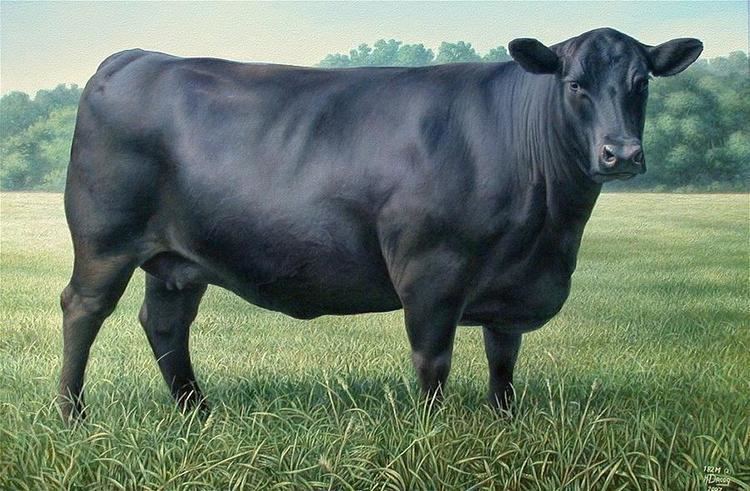 | ||
Similar Hereford, Charolais cattle, Simmental cattle, Wagyu, Limousin cattle | ||
Angus cattle history the history of the angus breed in america
Angus cattle, known as Aberdeen Angus in most parts of the world, are a breed of cattle commonly used in beef production. They were developed from cattle native to the counties of Aberdeenshire and Angus in Scotland.
Contents
- Angus cattle history the history of the angus breed in america
- Scotland
- Argentina
- Australia
- Canada
- United States
- Germany
- Characteristics
- Genetic disorders
- Uses
- Commercial
- References
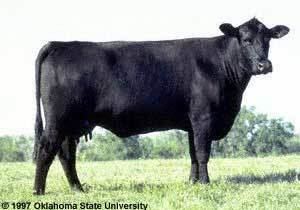
Angus cattle are naturally polled and solid black or red even though the udder may be white. The native colour is black, but more recently red colours have emerged. The UK registers both in the same herd book, but in the US they are regarded as two separate breeds – Red Angus and Black Angus. Black Angus is the most common breed of beef cattle in the US, with 324,266 animals registered in 2005. In 2014, the British Cattle Movement Service named Angus the UK's most popular native beef breed, and the second most popular beef breed overall.
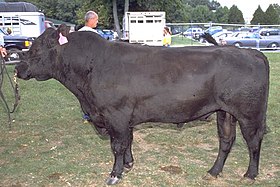
Scotland

Aberdeen Angus cattle have been recorded in Scotland since at least the 16th century in the country's North East. For some time before the 1800s, the hornless cattle in Aberdeenshire and Angus were called Angus doddies. In 1824, William McCombie of Tillyfour, M.P. for South Aberdeenshire, began to improve the stock and is regarded today as the father of the breed. Many local names emerged, including doddies or hummlies. The first herd book was created in 1862, and the society was formed in 1879. This is considered late, given that the cattle gained mainstream acceptance in the middle of the eighteenth century. The cattle became commonplace throughout the British Isles in the middle of the 20th century.
Argentina
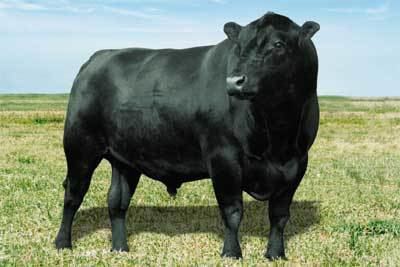
As stated in the fourth volume of the Herd Book of the UK's Angus, this breed was introduced to Argentina in 1879 when "Don Carlos Guerrero" imported one bull and two cows for his Estancia "Charles" located in Juancho, Partido de General Madariaga, Provincia de Buenos Aires. The bull was born on April 19, 1878; named "Virtuoso 1626" and raised by Colonel Ferguson. The cows were named "Aunt Lee 4697" raised by J. James and "Cinderela 4968" raised by R. Walker and were both born in 1878, on January 31 and April 23, respectively.
Australia
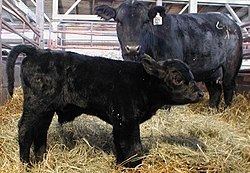
Angus cattle were first introduced to Tasmania (then known as Van Diemen's Land) in the 1820s and to the southern mainland in 1840. The breed is now found in all Australian states and territories with 62,000 calves registered with Angus Australia in 2010.
Canada
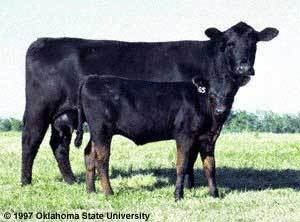
In 1876 William Brown, a professor of agriculture and then superintendent of the experimental farm at Guelph, Ontario, was granted permission by the government of Ontario to purchase Aberdeen Angus cattle for the Ontario Agricultural College. The herd comprised a yearling bull, Gladiolus, and a cow, Eyebright, bred by the Earl of Fife and a cow, Leochel Lass 4th, bred by R.O. Farquharson. On January 12, 1877, Eyebright gave birth to a calf, sired by Sir Wilfrid. It was the first to be born outside of Scotland. The OAC went on to import additional additional bulls and cows, eventually began selling Aberdeen Angus cattle in 1881.
United States
On 17 May 1873, George Grant brought four Angus bulls, without any cows, to Victoria, Kansas. These were seen as unusual as the normal American cattle consisted of Shorthorns and Longhorns, and the bulls were used only in crossbreeding. However, the farmers noticed the good qualities of these bulls and afterwards, many more cattle of both sexes were imported.
On 21 November 1883, the American Angus Association was founded in Chicago, Illinois. The first herd book was published on March 1885. At this time both red and black animals were registered without distinction. However, in 1917 the Association barred the registering of red and other colored animals in an effort to promote a solid black breed.
The Red Angus Association of America was founded in 1954 by breeders of Red Angus cattle. It was formed because the breeders had had their cattle struck off the herd book, for not conforming to the changed breed standard regarding colour.
Germany
A separate breed was cross bred in Germany called the German Angus. It is a cross between the Angus and several different cattle such as the German Black Pied Cattle, Gelbvieh, and Fleckvieh. The cattle are usually larger than the Angus and appear in black and red colours.
Characteristics
Because of their native environment, the cattle are very hardy and can survive the Scottish winters, which are typically harsh, with snowfall and storms. Cows typically weigh 550 kilograms (1,210 lb) and bulls weigh 850 kilograms (1,870 lb). Calves are usually born smaller than is acceptable for the market, so crossbreeding with dairy cattle is needed for veal production. The cattle are naturally polled and black in colour. They typically mature earlier than other native British breeds such as the Hereford or North Devon. However, in the middle of the 20th century a new strain of cattle called the Red Angus emerged. The United States does not accept Red Angus cattle into herd books, while the UK and Canada do. Except for their colour genes, there is no genetic difference between black and red Angus, but they are regarded as different breeds in the US. However, there have been claims that black angus are more sustainable to cold weather, though unconfirmed.
The cattle have a large muscle content and are regarded as medium-sized. The meat is very popular in Japan for its marbling qualities.
Genetic disorders
There are four recessive defects that can affect calves worldwide. A recessive defect occurs when both parents carry a recessive gene that will affect the calf. One in four calves will show the defect even when both parents carry the defective gene. The four recessive defects in the Black Angus breed that are currently managed with DNA tests are: Arthrogryposis Multiplex (AM), referred to as curly calf, which lowers the mobility of joints; Neuropathic Hydrocephalus (NH), sometimes known as water head, which causes an enlarged malformed skull; Contractural Arachnodactyly (CA), formerly referred to by the name of "Fawn Calf Syndrome", which reduces mobility in the hips; and Dwarfism, which impacts the size of calves. Both parents need to carry the genes for a calf to be affected with one of these disorders. Because of this, the American Angus Association will remove the carrier cattle from the breed in an effort to reduce the number of cases.
Between 2008 and 2010, the American Angus Association reported worldwide recessive genetic disorders in Angus cattle. It has been shown that a small minority of Angus cattle can carry osteoporosis. A further defect called notomelia, a form of polymelia ("many legs") was reported in the Angus breed in 2010.
Uses
The main use of Angus cattle is for beef production and consumption. The beef can be marketed as superior due to its marbled appearance. This has led to many markets, including Australia, Japan and the United Kingdom to adopt it into the mainstream. Angus cattle can also be used in crossbreeding to reduce the likelihood of dystocia (difficult calving), and because of their dominant polled gene, they can be used to crossbreed to create polled calves.
Commercial
Starting in the early 2000s, the American fast food industry began running a public relations campaign to promote the supposedly superior quality of Angus beef. Beginning in 2006, McDonald's commenced testing on hamburgers made with Angus beef in several regions in the US. After this test, the company said that customer response to the burgers was positive and began selling the burger made with Angus beef in all US locations in July 2009. In response to the test in the US, McDonalds Australia began selling two Angus burgers, the Grand Angus and the Mighty Angus, using Australian-bred Angus, in their restaurants.
The American Angus Association created the "Certified Angus Beef" (CAB) standard in 1978. The purpose of this standard was to promote the idea that Angus beef was of higher quality than beef from other breeds of cattle. Cattle are eligible for "Certified Angus Beef" evaluation if they are at least 51% black and exhibit Angus influence, which include black Simmental cattle and crossbreds. However, they must meet all 10 of the following criteria, which were refined in January 2007 to further enhance product consistency, in order to be labeled "Certified Angus Beef" by USDA Graders:
